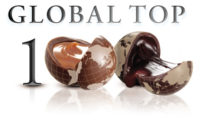
No doubts about who's No. 1
The 8th AnnualCandy IndustryTop 100 List offers something the previous seven compilations didn’t: A clear, without-a-doubt manufacturer perched firmly at the top of the global confectionery heap.Mars’s acquisition of Wm. Wrigley Jr. Co. in 2008 ends the back-and-forth battle between Mars, Nestlé and Cadbury. The Swiss multi-national headed the list in 2007, the British chocolate specialist in 2006. But the numbers between the top three, relatively speaking, were never that far apart, particularly in light of Mars’s fiscal secrecy and judgment calls about exactly which products from Nestlé’s vast stable of brands should count toward its net “confectionery” sales.
Adding Wrigley’s $5.5-billion-plus in revenues to Mars’ $10-billion-plus allows theSnickers maker to, well, snicker at the greater than 50-percent lead it now holds over its closest competitors. Barring another prominent acquisition, like the oft-rumored purchase of Hershey Foods by Cadbury, Mars should remain the world’s largest candy maker for some time to come.
All other buyouts in 2008 were dwarfed by the Mars-Wrigley deal-although two other prominent past members of the Top 100 were also swallowed up last year. Turkey’s Ülker Group picked up former No. 29 Godiva Chocolatier, boosting its own position from No. 15 to No. 12. And Lotte Confectionery acquired former No. 65 Chocolaterie Guylian.
Lotte’s deal, however, did little to advance its place on the list: partly because Guylian’s sales of $147 million didn’t have the impact of Godiva’s $500 million, much less Wrigley’s billions. Lotte’s drop from No. 18 to No. 22 had much more to do with the soaring U.S. dollar.
Since Dec. 1, 2007, the U.S. dollar gained 14% vs. the euro, 25% against the Mexican peso and 58% compared to the South Korean won. Seoul-based Lotte, as well as almost any EU or Mexican company (and manufacturers from other nations where the dollar’s charge reversed years of declines), often saw their Top 100 rankings slide despite sales gains as measured in their home currencies.
The Japanese yen was one of the few currencies to appreciate significantly (+16%) against the dollar, helping send confectionery makers like No. 9 Meiji Seika Kaisha, No. 13 Ezaki Glico and No. 15 Morinaga & Co. up the charts.
Currency fluctuations, however, had nothing to do with the appearance of nine new names on the list. Rather,Candy Industryresearch had previously overlooked a few, held one out on admittedly shaky definitional grounds and lacked reliable data on another. New facts and figures corrected those lapses in this year’s list.
Britain and the Ukraine added two companies apiece to the rolls: No. 56 Tangerine Confectionery and No. 70 Zetar from the UK, and No. 31 Konti Group and No. 47 AVK Co. from the former Soviet state and rising agricultural powerhouse.By virtue of its fruit snacks and broad line of snack bars, General Mills debuted at the highest position of any “new” entry: 26. Other previously overlooked first timers: Turkey’s Solen Cikolata ranked 60, Canada’s Biscuits Leclerc at 80, Nashville’s Standard Candy Co. at 83 and, the company that arrived purely by organic growth over the past two years: Brazil’s Chocolates Kopenhagen. Kopenhagen will need to keep that growth going to maintain its position, which is not a sure thing in today’s global economic climate.
One additional note, Cloetta Fazer “disappeared” from the listing, but not from sales or currency issues. Rather, it stemmed from the company’s “de-merger,” which resulted in the formation of two separate companies, Cloetta AB and Fazer Confectionery, a subsidiary of the Fazer Group.
Finally, although Mars may be firmly in place at the top of the list, the minimum dollar revenues required to make it jumped nearly $10 million in 2008, knocking off last year’s Nos. 96-100. And although confectionery has long been regarded as “recession-proof,” today’s uncertain and unprecedented business climate has made everyone anxious. One can only speculate as to how this list will look a year from now.










